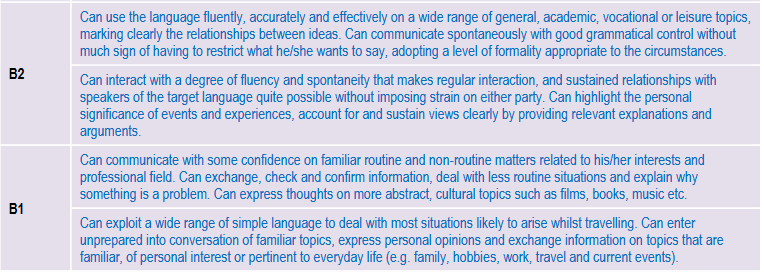To what extent can the CEFR framework help English teachers provide more detailed and personalised assessments of speaking performance? In our October workshop, we looked at the features to consider for an effective assessment of our learners’ speaking competence.
The participants of this workshop worked in very different English-teaching contexts. Some taught one-on-one, others to small groups and then there were teachers of larger groups of university students. The English taught ranged from conversational and general English to English for business or academic purposes. Some teachers assessed formally as examiners, whilst others used only informal assessment as part of their progress monitoring.
So the question arose: how can the (new) CEFR – Common European Framework of Reference for Languages – help fine-tune students’ speaking performance in such different contexts?
The key lay in being able to provide nuanced feedback. In doing so, teachers could help learners better understand their own competencies. Learners would then benefit from identifying where they are improving and where exactly they needed additional support.
What is speaking competence anyway?
First of all, we discussed what speaking competence actually entails. We divided speaking competence into core aspects.
- Linguistic aspects included those such as vocabulary and grammar.
- Phonological aspects included pronunciation and intonation.
- Sociolinguistic aspects covered what is appropriate language in different contexts and what can be cultural influences in a speaking situation.
- Finally, pragmatic aspects focussed on topics such as flexibility, fluency, and coherence.
Generally speaking, there is now the shared insight that language cannot be separated from communication and context. In other words, we have to consider the purpose, usage, and functionality of language in linguistic utterances.
For speaking competence, this means that we can divide speech production into two parts (or ‘topics’):
On the one hand, there is language production, for example:
- addressing an audience
- making announcements
- giving information
- putting a case
On the other hand, there is the field of interaction, including topics such as:
- conversation with friends
- formal meetings and discussions
- compensation strategies to make sure one can express things clearly
After this initial presentation, the participants worked in breakout rooms to discuss how the production and interaction descriptors (or “can do” statements) of the CEFR are able to help teachers in a needs analysis with their learners.

Using ‘Can Do’ statements for assessment
The group focussing on production had a look at the different descriptors for certain topics (such as making an announcement or addressing an audience). After picking those relevant to them, they engaged in a discussion:
- How can these descriptors be used to create a self-assessment questionnaire?
- How does one set tasks to assess whether the students can actually achieve their goals?
Examples of these tasks included short presentations, topical debates and personal or job introductions.
The group focussing on interaction started by selecting those descriptors that they thought were relevant to their learners. For example, “Learner is able to explain why something is a problem” and “Learner can give brief comments on the views of others” – both B2 descriptors for formal and informal discussions. Furthermore, they discussed descriptors for expressing an opinion or appropriate response to others.
Assessing audio recordings
Following that, we moved on to the more practical part, the analysis of two recordings. Recording One had a person introducing a speaker and the topic he was going to talk about at a company meeting. Recording Two was a group discussion focussing on agreeing and disagreeing, centred on an article the speakers had read. Both were authentic recordings from my teaching context.

The participants listened to both recordings and assessed the recordings based on a number of criteria. For Recording One (production) these criteria were accuracy, fluency, clarity and coherence. For Recording Two (interaction) these were active listening, checking for understanding, appropriateness of conversation, and the presence of turn-taking or communication breakdowns.
Assessing production
Regarding production – the introduction of speaker and topic – the participants reached agreement on an assessment. The speaker was B2, phonology, formality and fluency were quite good (if a little fast-paced) and speech was coherent and easy to follow. The group concluded that the speaker achieved the goals of the task. However, some thought the speech was too long for an introduction, containing pauses between thoughts and lacking connected speech.
In addition to that, I gave more background on the different features of speech that learners used, such as signposting and addressing the audience, argument presentation (including talking about challenges, giving examples and using rhetorical questions), and making announcements. The speaker managed all of these successfully. This background helped to achieve a more structured feedback that the teacher can give to the learner regarding the impact of the speaking performance.
Assessing interaction
In the interaction situation, participants assessed the way the speakers handled agreement and disagreement respectfully yet clearly; taking note also of the use of typical phrases and softeners to achieve this. Furthermore, the group analysed the reasons that the speakers gave to support their opinions and the language that they used to make comparisons. It was concluded that both speakers had reached a B1 level. Finally, it was agreed that both had achieved their main goal – expressing themselves clearly and politely.
Once more, I gave some background to help further structure the assessment. We looked at the phonology – how speakers used their voice to emphasise important points – and compensation strategies such as using the first language or defining words to avoid communication breakdown. There was also a discussion on clarification methods – how the speakers related back to what each other had said and how they helped out when the right word couldn’t be found.
Digital tools and final thoughts
The workshop was supplemented by looking into tools that can help our learners check on their own speaking performance. There are video recording tools that use automatic captions in the playback loop and examples of speaking performance can help teachers design tasks for their students. Vocabulary profiling tools can help assess student level, and an interview assessment conduct sheet is useful to check in a more detailed and formalised way what student performance looks like.
We all agreed that the most important point for our learners is to be intelligible when they communicate in English, and the participants gained some insights on how to support their learners better in this regard.
Resources
You can download a PDF of the CEFR with the new descriptors via this link.
***
If you found this article useful, you might be interested in this article on rubrics and feedback methods.
You might also enjoy this post on focussing on the positives and giving motivational feedback to your students and clients.

Kirsten Wächter
Kirsten Wächter has been a business English trainer based in Germany since 1998. Having taught in-company courses for many years, she now focuses on teaching business communication, English for specific purposes and intercultural courses. She has designed her own materials in this field and provides teacher training, too. You can find Kirsten on LinkedIn.







